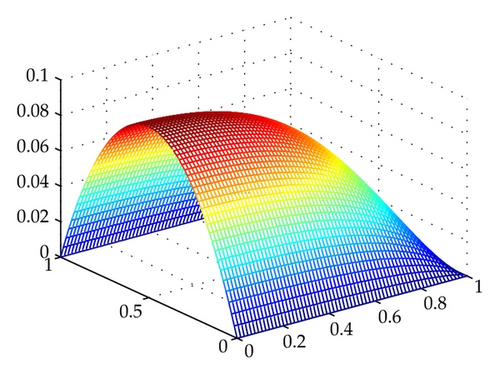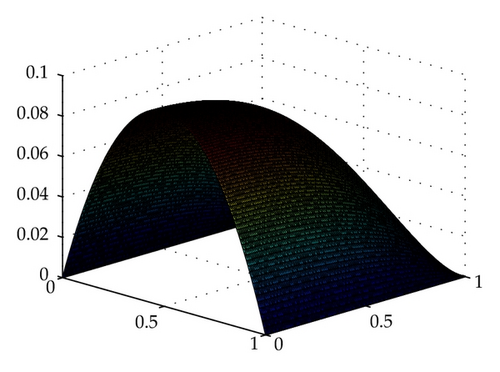Superconvergence Analysis of Finite Element Method for a Second-Type Variational Inequality
Abstract
This paper studies the finite element (FE) approximation to a second-type variational inequality. The supe rclose and superconvergence results are obtained for conforming bilinear FE and nonconforming EQrot FE schemes under a reasonable regularity of the exact solution u ∈ H5/2(Ω), which seem to be never discovered in the previous literature. The optimal L2-norm error estimate is also derived for EQrot FE. At last, some numerical results are provided to verify the theoretical analysis.
1. Introduction
Variational inequality (VI) theory has been playing an important role in the obstacle problem, contact problem, elasticity problem, and so on [1]. FE methods for solving VI problems have attracted more and more attentions. For example, as regards to the first type-VI case, the authors of [2] used piecewise quadratic FE to approximate the obstacle problem and suggested the error order between the FE solution and the exact solution should be O(h3/2). The authors of [3] first obtained the error bound O(h3/2−ε) (for any ε> 0) for the above FE when the obstacle vanished. Then through a detailed analysis, the authors of [4] obtained the same error bound as the ones of [3] under the hypothesis that the free boundary has finite length. Later, the authors of [5] obtained the same error bound as the ones of [3] for the same element without the hypothesis of finite length of the free boundary. Furthermore, [6] investigated the Wilson’s element approximation to the obstacle problem and derived the error bound with order O(h). The authors of [7] obtained the same error estimate with order O(h) on anisotropic meshes by making the full use of the bilinear part of the Wilson element, which relaxed the interpolation restriction and simplified the proofs of [5, 6]. Recently, the authors of [8] proposed a class of nonconforming FE methods for the parabolic obstacle VI problem with moving grids and obtained the optimal error estimates on anisotropic meshes. On the other hand, some studies [9–11] have been devoted to FE approximation to Signorini problem which arises in contact problems and obtained different error estimates under different assumptions. The authors of [12] derived the convergence result of O(h3/4 | log h|1/4) if the displacement field is of H2 regularity and also showed that if stronger but reasonable regularity is available (u ∈ W2,p, p > 2), the above result can be improved to optimal order O(h). The authors of [13] applied a class of Crouzeix-Raviart-type FEs to Signorini problem and obtained O(h) order estimate on anisotropic meshes. The authors of [14] used the bilinear FE to approximate the frictionless Signorini problem by virtue of the information on the contact zone and derived a superconvergence rate of O(h3/2) when the exact solution u ∈ H5/2(Ω). The authors of [15] presented the nonconforming Carey FE approximation to the problem of [14] and obtained the same convergence and superconvergence results are also obtained.
For the second type case, the authors of [16] proposed a Galerkin FE schemes for deriving a posteriori error estimates for a friction problem and a model flow of Bingham fluid. The authors of [17] considered the FE approximation to the plate contact problem and obtained some error estimates by employing the technique of mesh dependent norm.
In this paper, as a first attempt, we try to investigate the superconvergence of conforming and nonconforming FE schemes for problem (1.1) with a reasonable assumption of u ∈ H5/2(Ω). The rest of this paper is organized as follows. In the next section, we give the equivalent form of (1.1) and the conforming bilinear FE (see [14]) approximation of (1.1). Moreover, superclose result of O(h3/2) is derived under the broken energy norm. In Section 3, the nonconforming EQrot FE (see [26]) approximation is used, and the same superclose result is obtained under the energy norm; the optimal error estimate of L2-norm is also derived when u ∈ H2(Ω). In Section 4, we construct a postprocessing interpolation operator to obtain the superconvergence properties. In Section 5, we present some numerical results to verify the theoretical analysis.
2. The Equivalent Form and Conforming FE Scheme
Lemma 2.1. For all u ∈ H2(Ω), F ⊂ ∂K, there holds .
Lemma 2.2. Let u ∈ H5/2(Ω), then for , there holds
Theorem 2.3. Let u ∈ H5/2(Ω) be the exact solution of (1.1) and the bilinear FE solution of (2.6), then there holds
Proof. Subtracting (2.1) from (2.6), then taking v = vh in it, one can get
From (2.2) and Lemma 2.1, I1 can be estimated as
Applying the interpolation theory and Lemma 2.2, we get
The desired result follows directly from the combination of (2.12) and (2.13).
3. The Nonconforming FE Scheme
First, we introduce the following Lemma 3.1, which can be found in [25].
Lemma 3.1 (see [25].)If , one has
By using the similar technique in [26], one now states and proves the following important conclusion.
Lemma 3.2. For all , there holds
Proof. Let Z1 = (x0 − hx, y0 − hy), Z2 = (x0 + hx, y0 − hy), Z3 = (x0 + hx, y0 + hy), and Z4 = (x0 − hx, y0 + hy) be the four vertices of K, . We define operators P0 and P0i as
It can be checked that
By the definition of P01, we get
Noticing that equals and ∂vh/∂x is only dependent on x, we can derive that
Similarly, M2 + M4 ≤ ch3/2 | u|5/2,K | vh|1,K. By using the same technique as [14, 15], M can be estimated as
Thus the desired result follows.
Theorem 3.3. Let u ∈ H5/2(Ω) be the exact solution of (1.1) and the nonconforming FE solution of (3.1). Then one has
Proof. Subtracting (2.1) from (3.1) gives
For convenience, we still denote and . Taking in (3.10) yields
By Lemma 3.1, we can derive that
Noticing Lemma 3.2 and using the analysis technique of Theorem 2.3, one can immediately get the desired result.
Remark 3.4. As a by-product, if we assume u ∈ H2(Ω) instead of u ∈ H5/2(Ω), the consistency error can be estimated as
Now we start to give the L2-norm estimate through a duality argument.
Proof. Let ω ∈ H2(Ω) be the solution of the following auxiliary elliptic problem:
By (3.16) and Lemma 3.1, we can derive that
By the trace theorem, (3.17), and Lemma 2.1, one gets
The desired result follows the combination of the above estimates of J1, J2, and J3.
4. The Global Superconvergence Result
Theorem 4.1. If u ∈ H5/2(Ω) is the exact solution of (1.1), uh is the conforming or nonconforming FE solution. The following superconvergence result
5. Numerical Results
In this section, we will present an example to confirm the correctness of our theoretical analysis. In (1.1), we choose Ω = [0,1]×[0,1] with boundary . The right hand term f = 1. Since there may be no exact solution to the above problem, we use the conforming FE solution on a sufficient refined mesh h = 1/256 as the reference solution. Then we compare the conforming and nonconforming FE solutions (see Figure 1) on the coarser meshes (h = 1/2, 1/4, 1/8, 1/16, 1/32, 1/64) with the reference one in Tables 1 and 2.
| h | 1/2 | 1/4 | 1/8 | 1/16 | 1/32 | 1/64 |
|---|---|---|---|---|---|---|
| 2.1780E−02 | 6.6596E−03 | 1.8851E−03 | 5.1760E−04 | 1.3861E−04 | 3.5405E−05 | |
| order | / | 1.8084 | 1.8796 | 1.9084 | 1.9324 | 1.9786 |
| 5.3923E−03 | 1.5926E−03 | 4.1215E−04 | 1.0371E−04 | 2.5691E−05 | 6.1214E−06 | |
| order | / | 1.8401 | 1.9657 | 1.9935 | 2.0092 | 2.0486 |
| h | 1/2 | 1/4 | 1/8 | 1/16 | 1/32 | 1/64 |
|---|---|---|---|---|---|---|
| 1.1264E−01 | 4.6572E−02 | 1.8679E−02 | 8.0004E−03 | 3.1977E−03 | 1.3906E−03 | |
| order | / | 1.5552 | 1.5790 | 1.5280 | 1.5817 | 1.5164 |
| 8.1523E−02 | 3.1059E−02 | 1.0260E−02 | 3.1725E−03 | 9.4359E−04 | 2.7340E−04 | |
| order | / | 1.6201 | 1.7399 | 1.7983 | 1.8336 | 1.8578 |
| 1.0995E−02 | 2.7109E−03 | 6.4263E−04 | 1.5941E−04 | 3.9258E−05 | 9.3430E−06 | |
| order | / | 2.0139 | 2.0539 | 2.0078 | 2.0151 | 2.0498 |


From the above tables, we can see that the conforming and nonconforming FE solutions both converge. At the same time, the superconvergence results in our experiments are a little better than the theoretical ones. We may explain this phenomenon with some special properties of this nonconforming FE that we have not discovered.
Acknowledgments
The first author was supported by the National Natural Science Foundation of China under Grant 10971203. The third author was supported by the National Natural Science Foundation of China under Grant 11126132. The authors would like to thank the referees for their valuable suggestions and corrections, which contribute significantly to the improvement of the paper.




